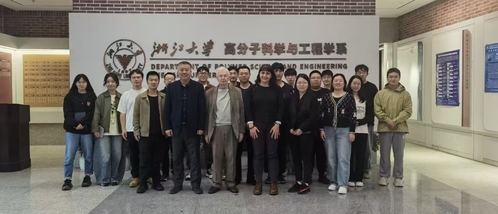
On November 15, 2024, at the invitation of Professor Gao Changyou, Professor Jean-Marie Lehn, member of the French Academy of Sciences, the father of supramolecular Chemistry, and winner of the 1987 Nobel Prize in Chemistry, paid a visit to the research group. The lecture entitled Steps Towards Complex Matter: Chemistry! was presented to all undergraduate students in the qiushi lecture hall. The keynote lecture, detailing the steps from molecules to the highly complex systems that make up living and thinking organisms, elaborates on all possible structures of molecular matter and transformations of the universe, where the professor introduces the key role of supramolecular action from the cosmic dimension. The question session was particularly lively. The students' questions covered a variety of cross-cutting areas, and Professor Jean-Marie Lehn also actively answered and discussed with the students.
Members of the research team then presented their work to Professor Jean-Marie Lehn. First of all, Chen Xiping gave a presentation on the topic of dynamic reversible polymers containing selenium. He gave a detailed report on the preparation of selenium-containing polymers, the proposal of the project and the progress made at present. Professor Lehn is one of the originators of the concept of dynamic polymers and has more than 20 years of experience in this field. Professor Lehn was very interested in the preparation of selenium-containing polymer, and after communicating with Xiping Chen to understand the polymerization mechanism, he gave valuable suggestions on the characterization of dynamic bonds and put forward opinions on the special properties of the selenium-containing polymer.
Subsequently, Wang Beiduo reported his work to the professors. A long-lived nanoparticle was used to treat acute lung injury, and the function of the new nanoparticle was comprehensively described from the preparation of the material to in vivo and in vitro experiments and mechanism analysis. The structure of the nanoparticles attracted the attention of Professor Lehn, and he discussed in detail with Beiduo Wang which part of the nanoparticles could prolong the resident effect and carried out a discussion.
Finally, Zheng Weiwei reported the work of restoring macrophage phagocytosis to reduce myocardial infarction damage. A lot of biological characterization work was carried out in the project, and the mechanism of action of selenium-containing materials was well explained from effect to mechanism. Professor Lehn discussed the stability of the structure containing selenium, and his colleagues Associate Professor Anne Petitjean and Zheng Weiwei discussed the details of the cell experiment and animal experiment.
The visit and exchange of the two professors have broadened the horizon of the students, which is of great significance. They not only give some guidance to the students in their work, but also let the students realize the significance of scientific research from a higher perspective, and provide valuable help for the students in their future scientific research life.

